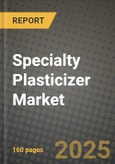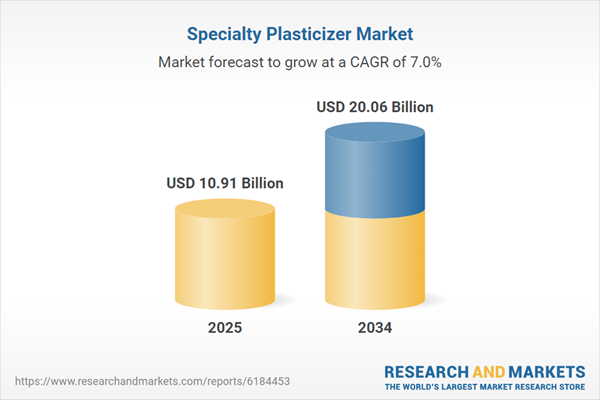Specialty Plasticizer Market
Specialty plasticizers are performance-driven additives engineered to impart flexibility, low volatility, extraction resistance, and durability in demanding PVC and non-PVC applications. Unlike commodity phthalates, specialty grades - adipates, trimellitates, cyclohexanoates, benzoates, citrates, sebacates, polymeric and epoxy-modified oils - are selected for specific property profiles such as low fogging in automotive interiors, high-temperature and electrical stability in wire & cable, blood-contact safety in medical devices, and stain/scuff resistance in luxury vinyl tile (LVT) and resilient flooring. Top end-uses include wire & cable compounds, automotive interior skins and dashboards, IV tubing and bags, flooring & wallcoverings, sealants/adhesives, film & sheet, and toys/consumer goods that require stricter migration and odor control. The market is shaped by accelerated regulatory pressure on legacy phthalates (REACH, Prop 65, global toy and medical standards), brand owner sustainability goals, and the need for longer product lifecycles under harsher operating conditions (EV harnesses, heat-aged components, outdoor cables). Key trends include substitution toward non-phthalate and low-VOC chemistries, rapid qualification of medical- and food-contact compliant grades, bio-based and mass-balance offerings with chain-of-custody certification, and closer collaboration between plasticizer suppliers and compounders for faster application-specific formulation. Competitive dynamics feature integrated chemical majors and specialty formulators expanding portfolios through new capacity, debottlenecking, and application development centers. Differentiation is increasingly anchored in regulatory stewardship dossiers, long-term stability data, and secure feedstock strategies for oxo-alcohols and organic acids. As demand tilts toward higher-value niches, suppliers with breadth across adipates, trimellitates, benzoates, polymerics, and certified bio-routes are best positioned to capture mix upgrades and defend margins.Specialty Plasticizer Market Key Insights
- Regulation as a structural tailwind. Tightening restrictions on legacy phthalates continue to accelerate reformulation toward non-phthalate and low-migration systems. Suppliers that maintain robust toxicology dossiers, global registrations, and customer audit readiness win recurring specifications across medical, toy, and food-contact applications.
- Performance segmentation deepens. Adipates dominate low-temperature flexibility; trimellitates and polymerics serve high-heat/low-volatility wire & cable and under-hood parts; benzoates/citrates target fast-gelling, low-odor flooring, sealants, and consumer goods. Clear performance maps shorten OEM qualification cycles and reduce reformulation risk.
- Medical device momentum. Hospital policies and OEM preference for DEHP-free PVC sustain demand for medical-grade cyclohexanoates, citrates, and trimellitates with hemocompatibility and extractables/leachables control. Lot-to-lot consistency, change-control rigor, and dual-sourcing remain decisive.
- Electrification and connectivity. EV wire harness density, fast-charging infrastructure, and 5G/FTTx rollouts expand requirements for heat-aged, dielectric-stable, and low-smoke cable compounds - favoring trimellitates, polymeric plasticizers, and specialty adipates with proven aging data.
- Flooring & interiors quality shift. LVT/resilient flooring and automotive interiors prioritize low VOC, anti-fogging, stain resistance, and plasticizer permanence. Benzoate blends and polymerics help balance processing speed with long-term aesthetics and emissions limits.
- Bio-based and mass-balance routes. Epoxidized oils, bio-citrates, and mass-balance adipates/trimellitates with third-party certification support brand decarbonization claims without sacrificing performance. Credible cradle-to-gate data and auditable chain of custody are becoming table stakes.
- Feedstock & supply resilience. Availability and pricing of 2-ethylhexanol, isononanol, trimellitic anhydride, benzoic/citric acids, and epoxidized oils drive cost curves. Integrated and regionally diversified producers mitigate volatility via backward integration and flexible synthesis pathways.
- Application development as a moat. Co-located pilot lines, rheology expertise, and joint formulation with compounders/OEMs speed up UL/IEC/ISO testing and field trials - translating into sticky specifications and cross-sell of adjacent grades.
- M&A and portfolio pruning. Players continue to optimize portfolios around non-phthalate, medical, cable, and flooring platforms, exiting undifferentiated commodity phthalates while scaling high-margin polymeric and trimellitate capacity and technical service.
- Qualification inertia protects incumbents. Long approval cycles in healthcare, automotive, and infrastructure make dislodging specified grades difficult. Suppliers with multi-year stability datasets, global logistics, and change-management discipline preserve share through market cycles.
Specialty Plasticizer Market Reginal Analysis
North America:
Demand is underpinned by medical devices, data-center and renewable-linked cabling, and renovation-led resilient flooring. Corporate VOC/odor limits and retailer chemical policies reinforce substitution toward non-phthalate systems. Producers emphasize security of supply, domestic compliance support, and rapid tech-service for UL and FDA-associated use cases. EV platform launches sustain high-heat cable and interior compound requirements.Europe
REACH compliance, circular-economy directives, and eco-label criteria drive the fastest mix shift toward low-migration and certified mass-balance/bio-based grades. Automotive lightweighting and cable fire-safety rules favor trimellitates and polymerics with stable dielectric and low fogging. Building retrofits and public infrastructure sustain resilient flooring and sealant demand, with stringent emissions caps guiding formulation.Asia-Pacific
China leads installed capacity and downstream compounding, with rapid adoption in wire & cable, appliances, and flooring exports. Japan and Korea favor high-spec trimellitates/polymerics for electronics and automotive interiors. India’s growth in power distribution, construction, and healthcare expands opportunities for medical-grade and cable-oriented plasticizers. Regional players compete on cost, while multinationals differentiate via compliance and application support.Middle East & Africa
Power grid expansion, industrial parks, and building programs sustain cable and PVC pipe compounds, creating pull for heat-resistant and extraction-resistant plasticizers. GCC petchem integration supports feedstock availability, while international brands influence low-VOC and non-phthalate adoption in flooring and consumer goods. Technical partnerships help bridge standards and qualification gaps.South & Central America
Infrastructure upgrades, residential renovation, and packaging growth drive demand for resilient flooring, sealants, and cable compounds. Local compounding clusters in Brazil and Mexico value reliable supply and cost-in-use performance. Regulatory convergence with North American standards gradually increases adoption of medical- and food-contact suitable specialties, favoring suppliers with regional technical service and steady logistics.Specialty Plasticizer Market Segmentation
By Type
- Phthalates
- Trimellitates
- Aliphatic dibasic esters
- Others
By Application
- Coated fabric
- Wire and cable
- Flooring and wall coverings
- Others
Key Market players
BASF SE, Eastman Chemical Company, Evonik Industries AG, ExxonMobil Chemical, Dow Inc., LG Chem, Arkema, LANXESS, DIC Corporation, Valtris Specialty Chemicals, UPC Technology Corporation, Nan Ya Plastics Corporation, Polynt Group, Perstorp Group, Bluesail Group Co., Ltd.Specialty Plasticizer Market Analytics
The report employs rigorous tools, including Porter’s Five Forces, value chain mapping, and scenario-based modelling, to assess supply-demand dynamics. Cross-sector influences from parent, derived, and substitute markets are evaluated to identify risks and opportunities. Trade and pricing analytics provide an up-to-date view of international flows, including leading exporters, importers, and regional price trends.Macroeconomic indicators, policy frameworks such as carbon pricing and energy security strategies, and evolving consumer behaviour are considered in forecasting scenarios. Recent deal flows, partnerships, and technology innovations are incorporated to assess their impact on future market performance.
Specialty Plasticizer Market Competitive Intelligence
The competitive landscape is mapped through proprietary frameworks, profiling leading companies with details on business models, product portfolios, financial performance, and strategic initiatives. Key developments such as mergers & acquisitions, technology collaborations, investment inflows, and regional expansions are analyzed for their competitive impact. The report also identifies emerging players and innovative startups contributing to market disruption.Regional insights highlight the most promising investment destinations, regulatory landscapes, and evolving partnerships across energy and industrial corridors.
Countries Covered
- North America - Specialty Plasticizer market data and outlook to 2034
- United States
- Canada
- Mexico
- Europe - Specialty Plasticizer market data and outlook to 2034
- Germany
- United Kingdom
- France
- Italy
- Spain
- BeNeLux
- Russia
- Sweden
- Asia-Pacific - Specialty Plasticizer market data and outlook to 2034
- China
- Japan
- India
- South Korea
- Australia
- Indonesia
- Malaysia
- Vietnam
- Middle East and Africa - Specialty Plasticizer market data and outlook to 2034
- Saudi Arabia
- South Africa
- Iran
- UAE
- Egypt
- South and Central America - Specialty Plasticizer market data and outlook to 2034
- Brazil
- Argentina
- Chile
- Peru
Research Methodology
This study combines primary inputs from industry experts across the Specialty Plasticizer value chain with secondary data from associations, government publications, trade databases, and company disclosures. Proprietary modeling techniques, including data triangulation, statistical correlation, and scenario planning, are applied to deliver reliable market sizing and forecasting.Key Questions Addressed
- What is the current and forecast market size of the Specialty Plasticizer industry at global, regional, and country levels?
- Which types, applications, and technologies present the highest growth potential?
- How are supply chains adapting to geopolitical and economic shocks?
- What role do policy frameworks, trade flows, and sustainability targets play in shaping demand?
- Who are the leading players, and how are their strategies evolving in the face of global uncertainty?
- Which regional “hotspots” and customer segments will outpace the market, and what go-to-market and partnership models best support entry and expansion?
- Where are the most investable opportunities - across technology roadmaps, sustainability-linked innovation, and M&A - and what is the best segment to invest over the next 3-5 years?
Your Key Takeaways from the Specialty Plasticizer Market Report
- Global Specialty Plasticizer market size and growth projections (CAGR), 2024-2034
- Impact of Russia-Ukraine, Israel-Palestine, and Hamas conflicts on Specialty Plasticizer trade, costs, and supply chains
- Specialty Plasticizer market size, share, and outlook across 5 regions and 27 countries, 2023-2034
- Specialty Plasticizer market size, CAGR, and market share of key products, applications, and end-user verticals, 2023-2034
- Short- and long-term Specialty Plasticizer market trends, drivers, restraints, and opportunities
- Porter’s Five Forces analysis, technological developments, and Specialty Plasticizer supply chain analysis
- Specialty Plasticizer trade analysis, Specialty Plasticizer market price analysis, and Specialty Plasticizer supply/demand dynamics
- Profiles of 5 leading companies - overview, key strategies, financials, and products
- Latest Specialty Plasticizer market news and developments
Additional Support
With the purchase of this report, you will receive:- An updated PDF report and an MS Excel data workbook containing all market tables and figures for easy analysis.
- 7-day post-sale analyst support for clarifications and in-scope supplementary data, ensuring the deliverable aligns precisely with your requirements.
- Complimentary report update to incorporate the latest available data and the impact of recent market developments.
This product will be delivered within 1-3 business days.
Table of Contents
Companies Mentioned
- BASF SE
- Eastman Chemical Company
- Evonik Industries AG
- ExxonMobil Chemical
- Dow Inc.
- LG Chem
- Arkema
- LANXESS
- DIC Corporation
- Valtris Specialty Chemicals
- UPC Technology Corporation
- Nan Ya Plastics Corporation
- Polynt Group
- Perstorp Group
- Bluesail Group Co. Ltd.
Table Information
| Report Attribute | Details |
|---|---|
| No. of Pages | 160 |
| Published | November 2025 |
| Forecast Period | 2025 - 2034 |
| Estimated Market Value ( USD | $ 10.91 Billion |
| Forecasted Market Value ( USD | $ 20.06 Billion |
| Compound Annual Growth Rate | 7.0% |
| Regions Covered | Global |
| No. of Companies Mentioned | 15 |









